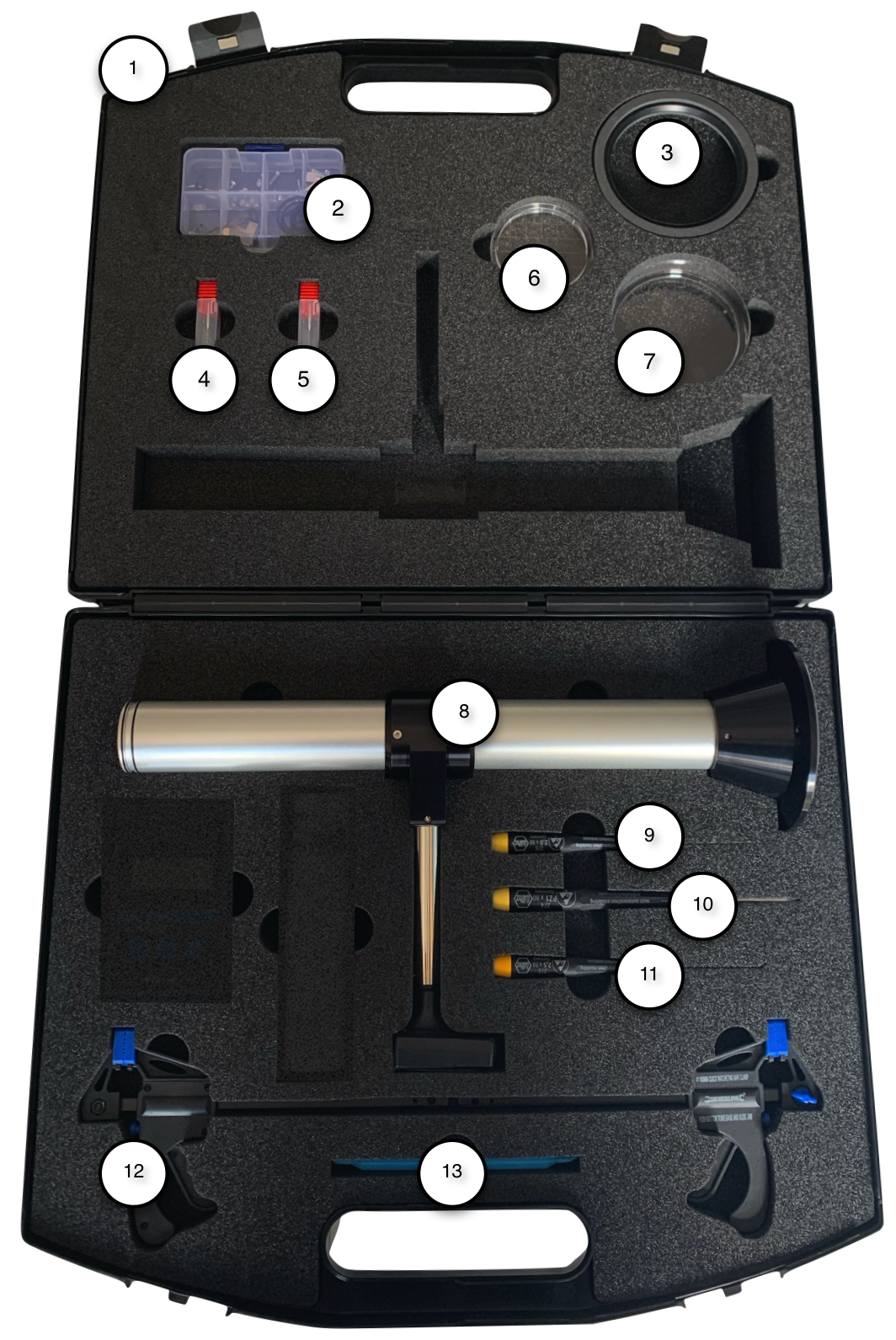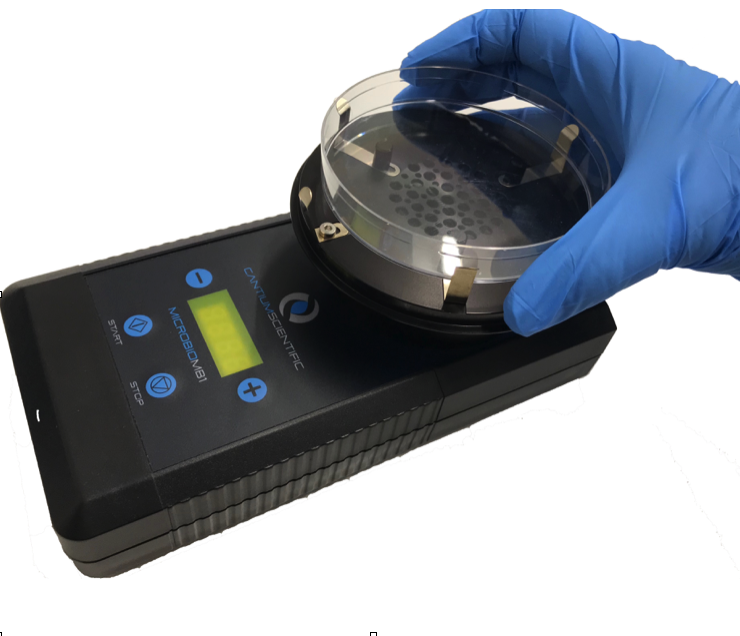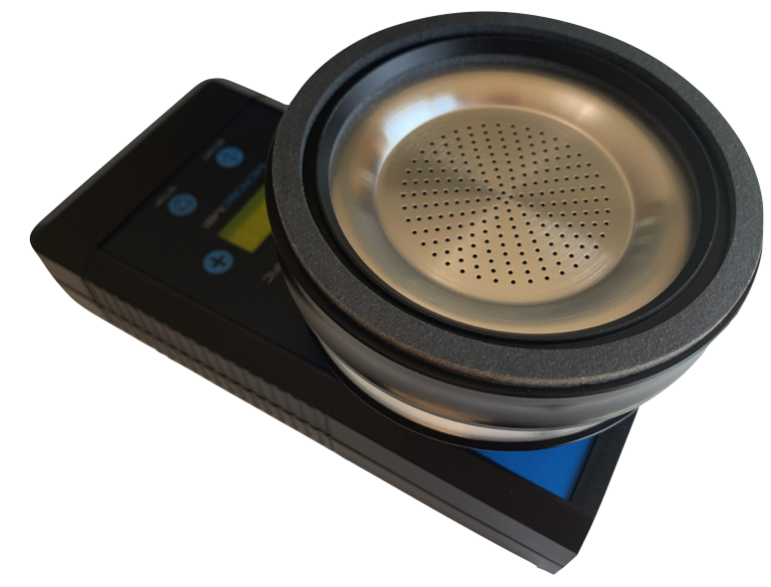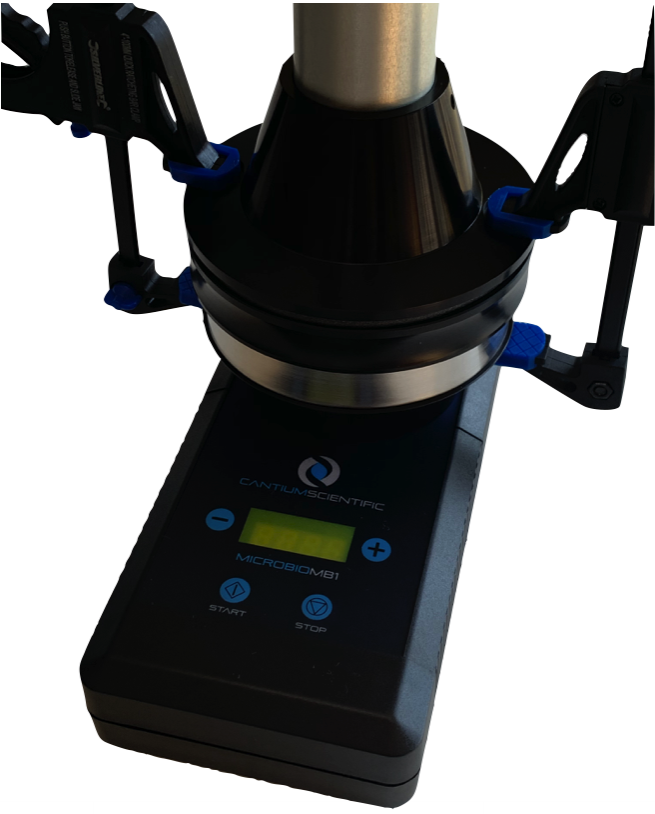Qualisair qCR Kit - Operating Manual
Introduction
The Qualisair™ qCR Validation Kit is the standard device used to calibrate the following models of bioaerosol samplers:
MicroBio MB1 (100 litres per minute)
MicroBio MB2 (100 litres per minute)
MicroBio MB2-HiFlow (180 litres per minute)
MicroBio MB2-RSH (100 litres per minute)
MicroBio MB2-RSH-HiFlow (180 litres per minute)
Qualisair samplers (100 and 200 litres per minute)
This device is for use only by qualified personnel with suitable training and experience. Please contact Cantium Scientific Limited for further details.
Regulatory Compliance - EC Declaration of Conformity
This is to certify that the Qualisair™ qCR Kit is designed to comply with the essential requirements of European Community Directives when used according to their intended purpose:
The kit contents comply with Restriction of the Use of Certain Hazardous Substances (RoHS) in Electrical and Electronic Equipment (EEE) Directive (2011/65/EU), namely BS EN 50581:2012.
The following devices supplied with the kit are certified by their respective manufacturers in relation to appropriate European Community Directives:
Testo Anemometer 405
Testo Ltd
Newman Lane
Alton. GU34 2QJ
United Kingdom
WEEE and Recycling
At the end of this product's life, please recycle responsibly.
Within the EU, take to an approved recycling centre, local authority collection point, or return to your local distributor who is obliged to take the product for safe recycling and disposal under the Waste Electrical and Electronic Equipment Directive 2012/19/EU. Outside of the European Union, consult local regulations or your local distributor.
The Qualisair qCR™ kit key parts are manufactured from the following:
Part |
Material |
Recyclable |
Anemometer* |
Electronic item |
Yes |
Tube assembly |
Aluminium |
Yes |
Screws and washers |
Stainless steel |
Yes |
Carry case |
ABS Plastic |
Yes |
Packaging |
Cardboard and PET |
Yes |
Documentation |
Paper |
Yes |
Batteries* |
Alkaline |
Yes, where facilities exist |
* These items must be taken to approved recycling centres equipped to handle such waste and recover the metals used in their manufacture. Some elements of these parts cannot be recycled.
Warranty
The manufacturer warrants this product to be free from defects in materials and workmanship for 36 months from the date of purchase.
If your product is found to be defective within that period, please contact Cantium Scientific Limited or your local distributor who will arrange for repair of the instrument, or if necessary a replacement. This warranty does not cover accidental damage, wear and tear, consequential or incidental loss.
Damage caused by cleaning materials and methods not recommended by the manufacturer, use beyond the specification, or modifications without prior permission from the manufacturer will invalidate the warranty. This warranty does not affect your statutory rights.
Kit Contents

Padded Kit Hard Case
Spares Pack
MicroBio Adapter
For using the calibration rig on MicroBio range of samplersDrill 0.7mm Carbide
For clearing holes on 400 x 0.7mm anodised aluminium headsDrill 1.0mm Carbide
For clearing holes on 220 and 400 x 1.0 mm stainless steel headsContact Plate 55mm (Rodac plate)
Petri dish 90mm Clear
Calibration Rig
Includes Testo anemometer and thermometerWIHA Precision ESD Hex Screwdriver 2.0mm
For head screws on MB1, MB2 and Qualisair samplersWIHA Precision ESD Pozidriv Screwdriver PZ1 x 60mm
For opening enclosures of MB1 and MB2 and head screws on older MB1 and MB2 samplersWIHA Screwdriver Slotted 50mm x 2.5mm ESD
For MicroBio MB1 and MB2 flow adjustmentSilverline 250108 Mini Clamps 100mm (x 2)
O-Ring Plastic Pick Tool
For removal and fitting of head seals on post 2017 MB2 samplersOperating Manual (not shown in picture)
Factory calibration certificate (not shown in picture)
Spares Pack
Supplied with the Qualisair™ qCR kit is a spares pack that contains the follow parts that are commonly used during service of samplers.

55m Contact plate springs (x 10)
MicroBio head retaining springs (x 5)
MicroBio MB2 head seals (x 2)
90mm Petri dish springs (x 10)
M3 x 3mm screws for head retaining springs (x 10)
M3 x 8mm screws for MB2 support plates (x 10)
MicroBio MB1 and MB2 battery contacts
Replacement content and additional spare parts are available from Cantium Scientific Limited or your local distributor. Refer to sampler service guides or manuals on how to replace parts.
Calibration Procedure
For all sampler models, the following steps are required for setting up the Qualisair™ qCR kit and the sampler to undertake calibration. Particular sampler models may require additional steps and reference to their service guides is recommended before proceeding further.
Calibration and validation should be carried out in a controlled environment and on a level surface. Air movement around the calibration zone should be minimised and ideally carried out in normal atmospheric pressure of 1013 mbar at 20°C.
Ensure the sampler has a fresh/charged battery pack.
If the sampling head mount of the sampler has an O-ring seal for air tightness, then ensure this is in good condition. Particularly for post 2017 MicroBio MB2 models. Replacement seals are contained in the spares pack of the Qualisair™ qCR kit along with an O-ring pick tool.
Check all the holes in the sampling head are clear. If not, then supplied in the Qualisair™ qCR kit are 1.0mm and 0.7mm drills to assist in removing any blockages.
Insert either 90mm petri dish or 55mm contact plate, depending on the configuration of the sampler.

Fit the sampling head (also referred to as the sieve cover) onto the sampler.
If calibrating a MicroBio model of sampler, then the MicroBio adapter ring must be fitted onto the MicroBio sampling head before fitting the calibration rig.

Place the calibration rig onto the top of the sampling head, or on top of the adapter ring, then clamp using the supplied mini quick-clamps. Only light pressure is required - do not over tighten. Ensure the faces of the clamps fit in the recesses on the calibration rig to ensure stability.

Switch on the anemometer on the calibration rig by pressing the power button. After the display shows ‘0.00 m/s’, press the power button once again to display the temperature and record this. Press the button twice again until the display shows ‘0.00 m/s’. The display on the anemometer may be angled to make viewing easier.

Start the sampler to sample at least 400 litres for a 100 litre per minute sampler and 1000 litres for a 180 litres per minute sampler. Please refer to the sampler operating manual for instructions on how to do this.
Wait 30 seconds for the anemometer to stabilise.
Every 10 seconds take a measurement from the anemometer until 12 readings have been taken. Then allow the sampler to complete the sample. It is normal for readings taken to vary by up to ±5% from the Anemometer Target value indicated on the Qualisair qCR ™ calibration certificate.
Using the sampler calibration certificate template, enter the temperature, pressure and air velocity measurements. The 12 readings are then averaged by the spreadsheet and used to determine an average and deviation of the air flow on the sampler.
The air flow velocity measured has a linear relationship to volumetric flow of the sampler, and the calibration certificate supplied with each Qualisair qCR™ kit gives the calibration factors that should be used for calibrating samplers at 60, 100, 120, 180 and 200 litres per minute with an expected range of measurement.
If using the sampler calibration certificate template spreadsheet, this performs the calculations for velocity, volumetric flow, deviation and indicates if the sampler is within calibration limits. If the sampler is not within limits, then adjustment of the flow rate is required. Please consult the sampler operating manual or service guide on how to do this.
For older MicroBio range of samplers there is a simple screw adjustment on the rear panel of the sampler. This is normally covered by a calibration date label that must be removed. The Qualisair™ qCR kit is supplied with a suitable slot screwdriver. Current models are digitally controlled via the keypad.
The spreadsheet, or the Qualisair™ qCR kit calibration certificate, will give the ideal velocity for a given flow rate. The sampler should be adjusted as close as possible to this.
When adjusted as close as possible to the Anemometer Target value, repeat the calibration procedure steps 10 to 13.
If it is not possible to increase or decrease the flow rate to the required point, this may indicate a fault with the air sampler. For service, contact Cantium Scientific Limited or your local distributor.
NOTE: It is important not to obstruct the exhaust vents of the sampler or the inlet of the calibration rig during the test.
NOTE: The upper tube on the calibration rig has air flow guide tubes inserted around the inner wall. DO NOT TOUCH THE TUBES.
Maintaining the Qualisair™ qCR Kit
When not in use, the kit should always be stored in the padded carry case and kept in a clean dry environment. The kit should be cleaned with a lint free soft dry cloth.
Regular inspection of head mounting foam seals should be undertaken. Replacements can be ordered from Cantium Scientific Limited.
If required, the kit can be returned to Cantium Scientific Limited or your local distributor for independent inspection or maintenance.
Additional Technical Support
Should you require technical support for the Qualisair™ qCR kit please contact Cantium Scientific Limited or your local distributor, via our technical support portal.
Authorised service agents registered on Cantium Scientific Limited’s website can access further technical support on distributor and agent only pages.
IQ/OQ/PQ
Documentation to support IQ/OQ/PQ for use within pharmaceutical and related industries is available upon request by contacting Cantium Scientific Limited or your local distributor.
Calibration of the Validation Kit
Calibration of the Qualisair™ qCR kit shall only be undertaken by Cantium Scientific Limited. It is recommended this is done annually. Please arrange calibration through your local distributor or directly with Cantium Scientific Limited.